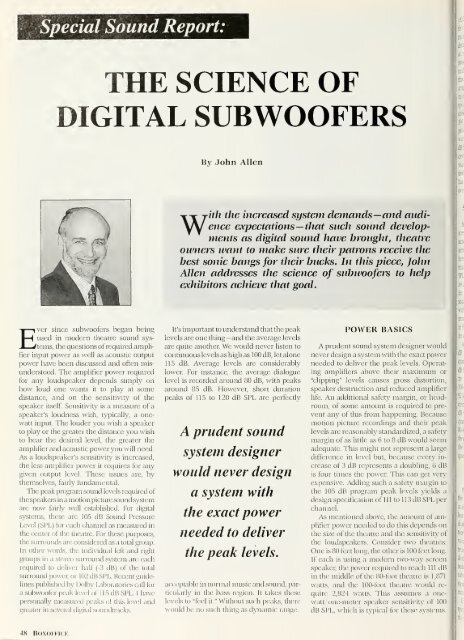Create successful ePaper yourself
Turn your PDF publications into a flip-book with our unique Google optimized e-Paper software.
Special Sound Report:<br />
THE SCIENCE OF<br />
DIGITAL SUBWOOFERS<br />
By John Allen<br />
With<br />
the increased system demands—and audience<br />
expectations— tliat such sound dei'clopnients<br />
as digital sound have brought, theatre<br />
ownei's want to make sure their patroits receive the<br />
best sonic bangs for their bucks. In this piece, John<br />
Alien addresses the science of subwoofers to help<br />
exhibitors achieve tltat goal.<br />
Ever since subwoofers began being<br />
used in modern theatre sound systems,<br />
the questions of required amplifier<br />
input power as well as acoustic output<br />
power have been discussed and often misunderstood.<br />
The amplifier power required<br />
for any loudspeaker depends simply on<br />
how loud one wants it to play at some<br />
distance, and on the sensitivity of the<br />
speaker itself Sensitivity is a measure of a<br />
speaker's loudness witli, typically, a onewatt<br />
input. The louder you wish a speaker<br />
to play or the greater the distance you wash<br />
to hear the desired level,<br />
the greater the<br />
amplifier and acoustic power you will need.<br />
As a loudspeaker's sensitivity is increased,<br />
the less amplifier power it requires for any<br />
given output level. Tliese issues are, by<br />
themselves, fairly flmdamental.<br />
The peak program sound levels required of<br />
the speakers in a motion picture sound system<br />
are now fairly well established. For digital<br />
systems, these are 105 dB Sound Pressure<br />
Level (SPL) for each channel as measured in<br />
the renter of the tlneatre. For tliese puiposes,<br />
the surrounds are rx)nsidered as a total gi'oup.<br />
In other words, the individual left and right<br />
grotips in a stereo surround system are each<br />
required to deliver lialf (-3 dB) of the total<br />
surround i»wer, or l()2dBSPL. Recent guidelines<br />
published by Dolby Laboratories call for<br />
a subwoofer peak If^vel of 11.S dB SPL. I have<br />
personally measured peaks of this lev(;l and<br />
great(;r in several digittil soundtracks.<br />
It's impottant to understand tliat the peak<br />
levels are one thing— and tlie average levels<br />
are quite another We would never listen to<br />
continuous levels as high as 100 dB, let alone<br />
115 dB. Average levels are considerably<br />
lower For instance, the average dialogue<br />
level is recorded around 80 dB, with peaks<br />
around 85 dB. However, short duration<br />
peaks of 115 to 120 dB SPL are perfectly<br />
A prudent sound<br />
system designer<br />
would never design<br />
a system with<br />
the exact power<br />
needed to deliver<br />
the peak levels.<br />
acceptable in normal music and sound, particularly<br />
in the bass region. It takes these<br />
levels to "feel it." Without such peaks, there<br />
would be no sui h thing ,is dynamic range'.<br />
POWER BASICS<br />
A prudent sound sj'stem designer wotild<br />
never design a system with the exact power<br />
needed to deliver the peak levels. Operating<br />
amplifiers above their maximum or<br />
"clipping" levels causes gross distortion,<br />
speaker destruction and reduced amplifier<br />
life. An additional safet\' margin, or headroom,<br />
of some amount is required to prevent<br />
any of tliis fi'om happening. Because<br />
motion picture recordings and tlieir peak<br />
levels are reasonably standardized, a safety<br />
margin of as little as 6 to 8 dB would seem<br />
adequate. This might not represent a large<br />
difference in level but, because evePi' increase<br />
of 3 dB represents a doubling, 6 dB<br />
is four times die power This can get very<br />
expensive. Adding such a safety margin to<br />
the 105 dB program peak levels yields a<br />
design specification of 111 to 113dBSPLper<br />
channel.<br />
As mentioned above, the amount of amplifier<br />
power needed to do this depends on<br />
the size of the theati'c and the sensitix'ity of<br />
the loutispeakere. Consider two theatres:<br />
One is 80 teet long, the otliei' is 100 feet long.<br />
If each is using a modern two-way screen<br />
speaker, the power required to reach 111 dB<br />
in the middle of tlie 80-foot tlieatie is 1 ,871<br />
watts, and the 100-foot tlieatre would require<br />
2,924 watts. This assiunes a onewatt<br />
'one-meter speaker S(Misiti\it\' ot 100<br />
dB SPL, whic h is t\iiir,il tor these systems.<br />
48 BOXOFFICK

















